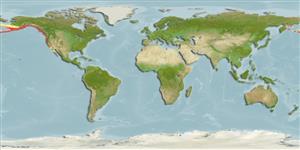Common names from other countries
Issue
Hybridizes with Platichthys stellatus - the hybrid, called Inopsetta ischyra, may be found from the Bering Sea to San Francisco, California, USA.
Environment: milieu / climate zone / depth range / distribution range
Ecologia
marino demersale; oceanodromo (Ref. 51243); distribuzione batimetrica 0 - 550 m (Ref. 6793). Temperate; 61°N - 28°N, 163°E - 114°W
Eastern Pacific: from Russia to Agattu Island, north to Nunivak Island, Alaska, then South to Mexico, Baja California, Mexico.
Length at first maturity / Size / Peso / Age
Maturity: Lm 31.0, range 30 - 32 cm
Max length : 49.0 cm TL maschio/sesso non determinato; (Ref. 6885); 57.0 cm TL (female); common length : 33.0 cm TL maschio/sesso non determinato; (Ref. 56527); peso massimo pubblicato: 1.5 kg (Ref. 56527); Età massima riportata: 22 anni (Ref. 55701)
Short description
Chiavi di identificazione | Morfologia | Morfometria
Spine dorsali (totale) : 0; Raggi dorsali molli (totale) : 72 - 92; Spine anali: 0; Raggi anali molli: 45 - 70; Vertebre: 41 - 44. Dorsal origin above middle of upper eye. Pectorals inclined to be pointed.
Adults inhabit sand and mud bottoms (Ref. 4925). Young occur in intertidal areas. Feed on small crustaceans, marine worms, brittle stars and small mollusks (Ref. 6885). Spawning adults make extensive migrations (Ref. 6885).
Vinnikov, K.A., R.C. Thomson and T.A. Munroe, 2018. Revised classification of the righteye flounders (Teleostei: Pleuronectidae) based on multilocus phylogeny with complete taxon sampling. Molecular phylogenetics and evolution, 125:147-162. (Ref. 122998)
IUCN Red List Status (Ref. 130435)
CITES (Ref. 128078)
Not Evaluated
Threat to humans
Harmless
Human uses
Pesca: commerciale; Pesce da pesca sportiva: si
Strumenti
Special reports
Download XML
Fonti Internet
Estimates based on models
Preferred temperature (Ref.
115969): 3.4 - 8.3, mean 5.6 (based on 245 cells).
Phylogenetic diversity index (Ref.
82804): PD
50 = 1.0000 [Uniqueness, from 0.5 = low to 2.0 = high].
Bayesian length-weight: a=0.00575 (0.00358 - 0.00924), b=3.03 (2.89 - 3.17), in cm Total Length, based on LWR estimates for this species & (Sub)family-body (Ref.
93245).
Trophic level (Ref.
69278): 3.4 ±0.46 se; based on food items.
Resilienza (Ref.
120179): Medio, tempo minimo di raddoppiamento della popolazione 1.4 - 4.4 anni (tm=3; tmax=22; K=0.24; Fec=150,000).
Fishing Vulnerability (Ref.
59153): Moderate vulnerability (43 of 100).
Climate Vulnerability (Ref.
125649): Low to moderate vulnerability (27 of 100).
